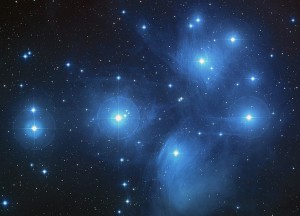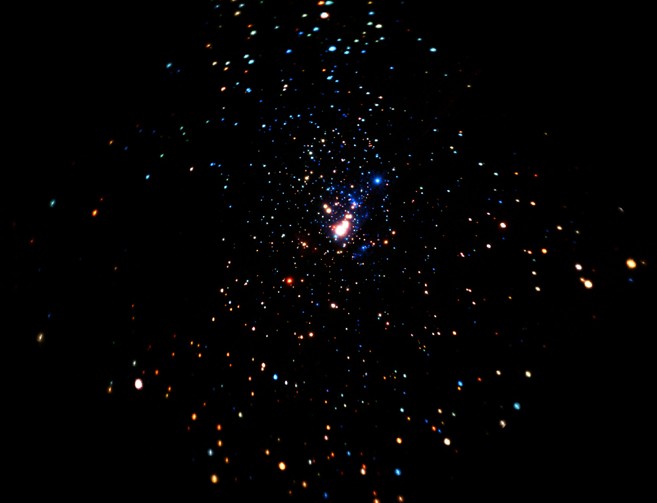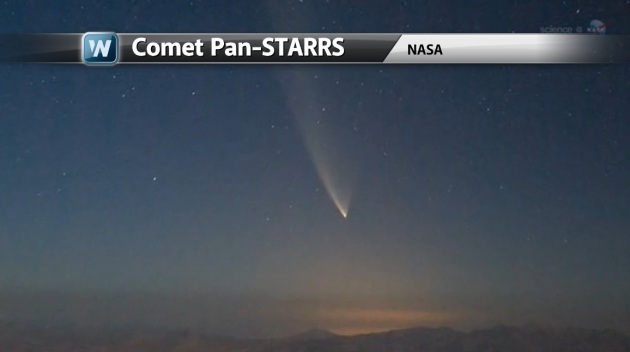Posts Tagged ‘moon’
1st Star Gaze Of The Year
After several months of pants weather in the evenings which stopped me from doing any stargazing, last night finally had a clear enough sky to have a good look again. The moon was ideally positioned as well which made the stars and planets on show very bright. I didn’t get the telescope out this time but used my binoculars instead to have a scan around the Sky.
The most noticeable object in the Sky was the planet Jupiter which was shining very brightly, so I had a good look at it and managed to pick out three of Jupiter’s moons. One was to the right of it and two more underneath it, and I could also just pick out the horizontal storms raging across the planet. As I was using binoculars, the image wasn’t very steady, so I was desperately trying to lean against the shed to steady myself!
Once I had had a good look at Jupiter, I had a look at the Pleiades (also known as ‘The Seven Sisters’) which are one of my favourite things to view in the night sky. They were shining brilliantly via the binoculars although quite dimmed out when looking with the naked eye. It still amazes me how well you can see these stars through a telescope or binoculars as it really brings them to life! The Pleiades are located in the constellation of Taurus and are one of the closest star clusters to Earth. Here is a great photo of them from the NASA website.
The final section of the sky that I had a good look at last night was the Orion Nebula which is situated in the sword of the constellation Orion. As the Nebula is in the middle of the three star sword, it is easily spotted in the sky. You can just make out a blurry area with the naked eye, but using the binoculars as I was, I had a great view of the Nebula. The Nebula is also known as M42 and is 24 light years across with the mass being almost 2000 times that of the Sun. It is also the closest star forming region to the Earth which adds to its significance. I find it amazing to look at this and imagine new stars and worlds being formed in a distant part of the galaxy. Here is a photo of the Orion Nebula from the NASA website.
Here’s hoping for more clear skies over the next few weeks!
Eta Aquarids Meteor Shower 2013
For those of you who are very early risers in the morning, the Eta Aquarids Meteor Shower is for you! Unfortunately, for those of us who can’t get up in the morning we will probably miss this shower, as the best time to view these meteors is in the couple of hours before dawn. This is when the radiant of the meteor shower comes over our horizion in the Northern Hemisphere.
The good thing about this meteor shower is that you can see the meteors several days before the peak, which is on May 5th, and then for several days after. I believe the full timescale is from the 19th April until the 28th May, so they can be seen for over a month, if you are willing to get up in the morning! The number of meteors that should be seen each hour could peak at about 70 per hour if you are lucky, but you are more likely to see around 10-20 per hour in the Northern Hemisphere, with each meteor travelling at approx 66km/s. This year is actually a very good year to view the Eta Aquarids as the moon is only a waning crescent so will not make the sky too bright.
This meteor shower is called the Eta Aquarids as the radiant of the shower looks to emanate from the star Eta in the constellation of Aquarius. Aquarius is also known as the ‘Water Bearer’ and is shown in the image below. The meteors from this shower are actually dust and debris left behind from Halleys Comet, with this shower coming about due to the Earth passing through this orbital path of the Comet and thus ploughing straight through the path of debris
Lyrid Meteor Shower 2013
Unfortunately, this year the viewing of the Lyrid meteor shower will be hindered by a very bright and almost full Moon (if you get clear skies that is)! It’s a real shame as the Lyrid meteor shower is one of the best ones of the year. Having said that, if you are out on its peak, which is today (the 22nd April), you may still spot the brighter meteors, but obviously these will be far fewer than if it was a clear sky as you would see the fainter ones as well.
My wife and I went out last Friday evening (19th) to try and have a look as it was a very clear sky and the Moon wasn’t quite as bright as it would be tonight, and I managed to see one very faint meteor (I think) in the distance, but that was about it. We gave up on the meteors after about half an hour as it was still just too bright and the direction they come in is close to the horizon for us where a lot of trees are situated. If it clears up again tonight, I will go out and try and view them again (with my fingers crossed!).
One good thing that came out of viewing last Friday, was that I saw 2 satellites and also the International Space Station fly over (the first time for both this year due to the constant bad weather we have had!). I always enjoy viewing the ISS, even though you don’t really see much, as it still amazes me that that is a space station which we can see shining bright from Earth. I would be happy to view it every night if I could! 😉
Anyway, happy meteor spotting tonight and leave a comment on here or my twitter account (@strethewey) if you do manage to see anything!
Comet Spotting – Attempt #3
Last night we went out again to try and find Comet Pan-Starrs as it was a clear night, but unfortunately, we didn’t manage to see it. There was a band of cloud along the horizon where I am sure the Comet would have been, and it was also very frosty so the atmosphere of the Earth wasn’t as clear as it had been the previous nights when we have been out. It was a bit of a shame, but we at least saw the Comet on our second attempt which was great!
Instead last night, we had a look around at the other objects in the Sky with our binoculars. Jupiter was very bright and you could see a couple of it’s Moon’s shining beside it, and we also had a good look at the Pleiades (also known as the ‘Seven Sisters’ as they are a group of seven stars that shine very brightly. The Pleiades were clear as a bell through the binoculars and were a great site! Finally, we had a go at looking for the Orion Nebula and that was showing really well. You could see a blurry, but large, mass of stars which make up the Nebula in the sword of the Constellation Orion (just south of Orion’s belt). It was a great view!
So whilst we were annoyed we couldn’t see the Comet again, we had a good time looking at some of the other features that make up the night sky!
Comet Spotting – Attempt #2 – SUCCESS!
After not being sure if we would make it out this evening due to Kelly being ill all last night and this morning and the strange weather that we have had today (rain, sleet, hail and snow!), we did manage to go out, and I am very glad that we did as we spotted the Comet!! 😉
Instead of going to Jenny Cliff, we made the shorter journey up to Shaugh Prior on Dartmoor, as we knew of a good vantage point there, and arrived shortly after sunset (about 18:30 with sunset being 18:18). The Moon was a lot higher in the Sky tonight than last night, and a lot easier to spot as it was a much brighter crescent. So we had a good look around it but couldn’t see anything to start with and it took about 25-30 minutes to spot anything remotely that looked like a Comet.
When I did finally spot something, the object that I saw was very slowly moving across the Sky horizontally and in the general area of where we thought the Comet ought to be. It also had a very long but dark smoky tail but the head of it didn’t have any lights or a brightness to it. We honestly didn’t (and still don’t) know what this object was – it definitely wasn’t an Airplane – it looked more like a meteor to me but who knows!!
At about 19:10 I decided to have one final look (it was absolutely freezing cold) and just had a general scan of the Sky underneath and around the Moon, and finally spotted it! It was very faint and to the lower right of the Moon (not to the lower left as on previous nights) but it was unmistakeable. You could see the head of the Comet being lit up by the Sun and the long tail reaching out behind it almost vertically. We couldn’t see the twin tail unfortunately, but we were very glad that we finally saw it after nearly giving up! It was a very exciting 10-15 minutes looking at it (whilst a Tawny Owl was calling in the nearby trees which did make it a bit creepy though!).
Here is an image from NASA that looks almost exactly the way we saw it, although it wasn’t quite as bright as this tonight.
Tomorrow is the last day of decent weather for the next few days, so we will be going out again to Shaugh Prior to have another look. Am hoping we will get an even better view of it! 😉



